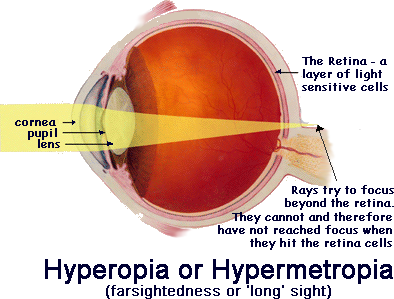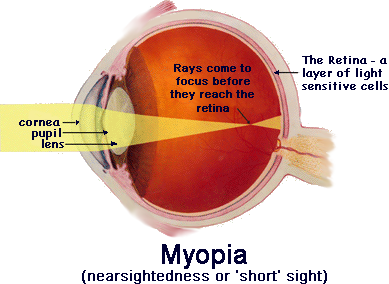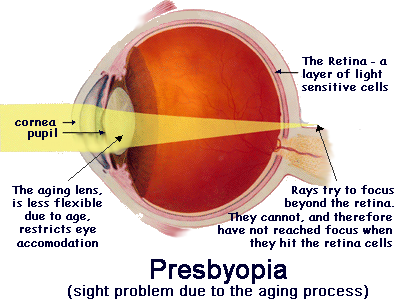Distinguishing Common Vision Defects
We know that not all of us are born with perfect vision. In fact, it's rather rare for children to grow up without ever suffering from blurry vision, or in many cases Astigmatism. But there are also a number of other eye problems, some of which people are born with, and some of which occur over time as bodily deterioration.
In this article, we will discuss three common types of problems with vision:
 Hyperopia (or Hypermetropia),
Hyperopia (or Hypermetropia),
 Myopia, and
Myopia, and
 Presbyopia.
Presbyopia.
 Hyperopia (or Hypermetropia), Hyperopia (or Hypermetropia),
The more common name for Hyperopia is farsightedness (American term) or long sight (British term).
It describes the issue of being able to see objects at a distance, but not up close. The disorder occurs because the eye's cornea - the front part of the eye - is too flat, and the eye is too short from front to back. This impacts the way that the eye is able to receive light (which is imperative in vision), and results in close-up objects appearing blurry or indistinct. |
 Myopia Myopia
Myopia is what we commonly hear referred to as nearsightedness or short sight.
As such, it refers to the condition of being able to see objects clearly up close, but not at a distance. The problem is often identified in children, and is described essentially as the opposite of Hyperopia in every way. The eye is too "long" from front to back, and light is brouht to a focus point before it reaches the retina at the back of the eye and has begun to spread out again by the time it reaches the retina cells.
This is the opposite problem to Hyperopia where the light spreads out in such as way that it should come to a focus beyond the retina. With Hyperopia it has not focused before it reaches the cells on the retina, whereas with Myopia it already has.
Myopia is the condition that leads to common description of vision in relation to the idea of "20/20." For example, if one has 20/40 vision, it means that person can clearly see at 20 units of distance what someone with perfect vision can see clearly at 40. |
 Presbyopia Presbyopia
Presbyopia is an issue that is specifically related to age. It is said to affect just about everybody after the age of 40 or 50.
Research evidence most strongly supports that it is caused by a loss of elasticity of the crystalline lens, although changes in the lens' curvature from continual growth as you age and loss of power of the ciliary muscles (the muscles that bend and straighten the lens) have also been postulated as its cause.
This means that the eye becomes less flexible with age, and therefore has trouble adjusting to focus on close objects. That is why middle aged and elderly people need their 'reading glasses' on when looking at small print.
 Take a look at this page on the Acuvue online site. It describes how the condition affects someone who suffers from it and provides a 'self test' that you can carry out to find out if you need reading glasses... or try out on a parent that you suspect needs them! Take a look at this page on the Acuvue online site. It describes how the condition affects someone who suffers from it and provides a 'self test' that you can carry out to find out if you need reading glasses... or try out on a parent that you suspect needs them!
|
 for the GCSE and A Level note pages on this topic
for the GCSE and A Level note pages on this topic









